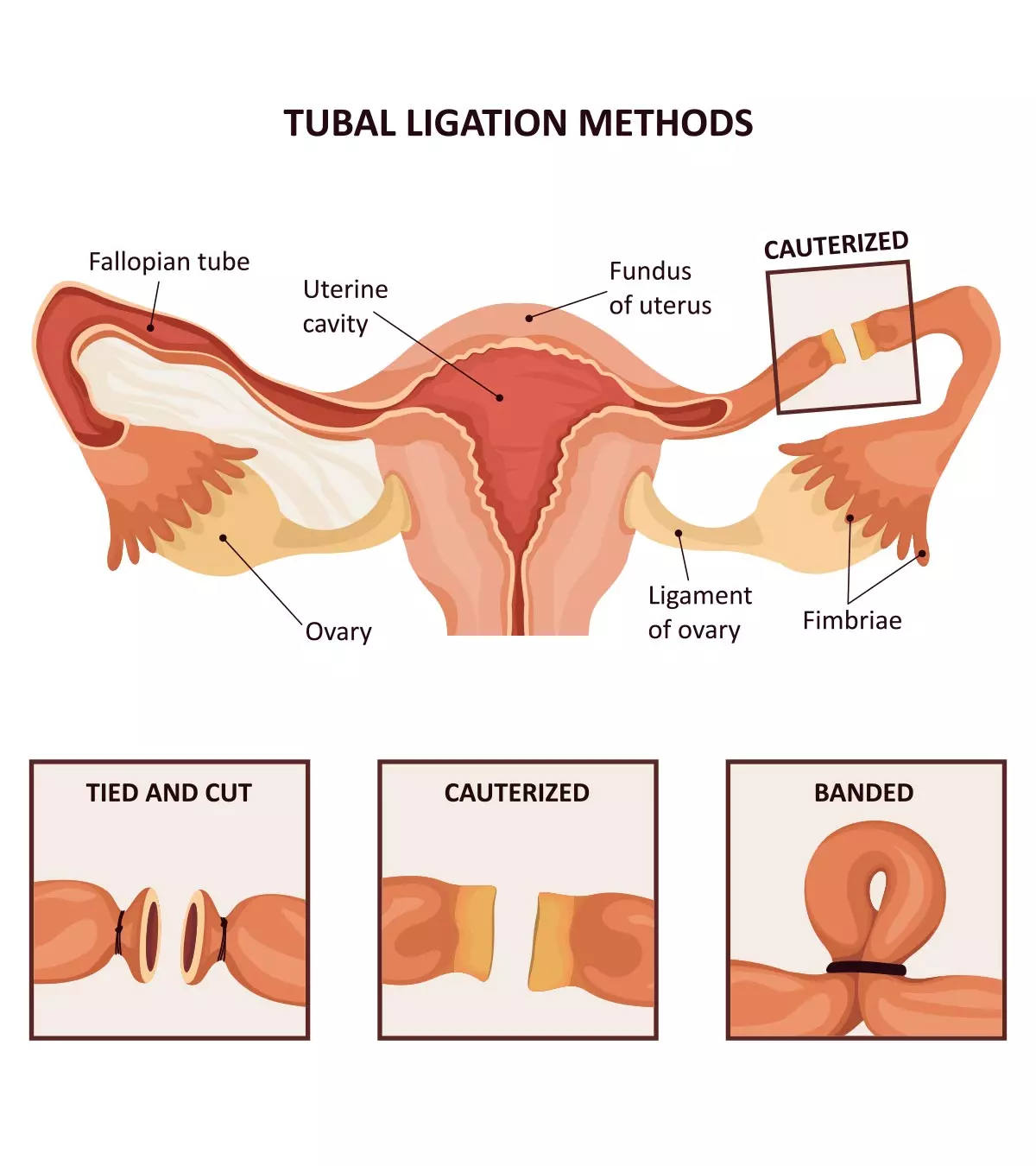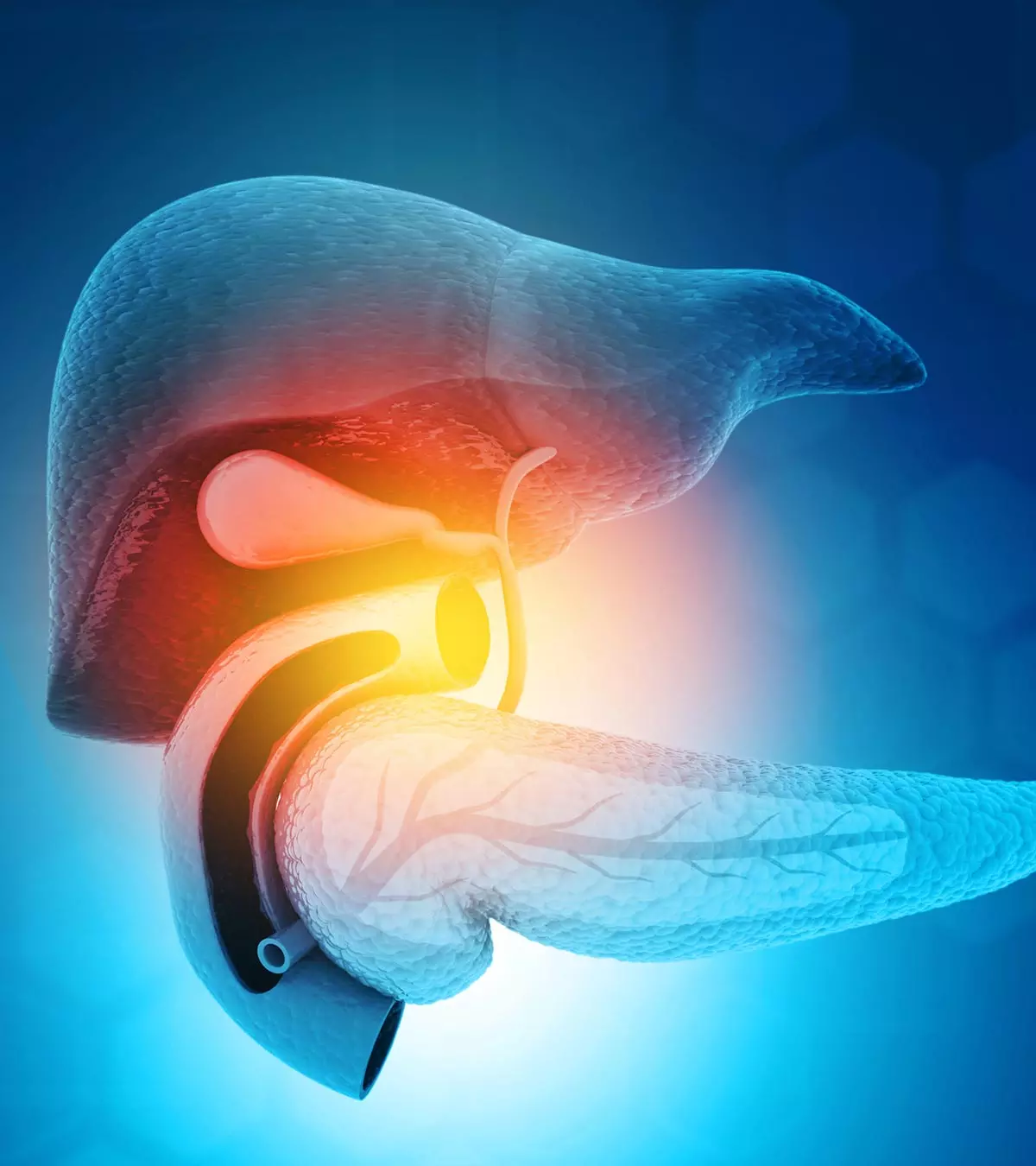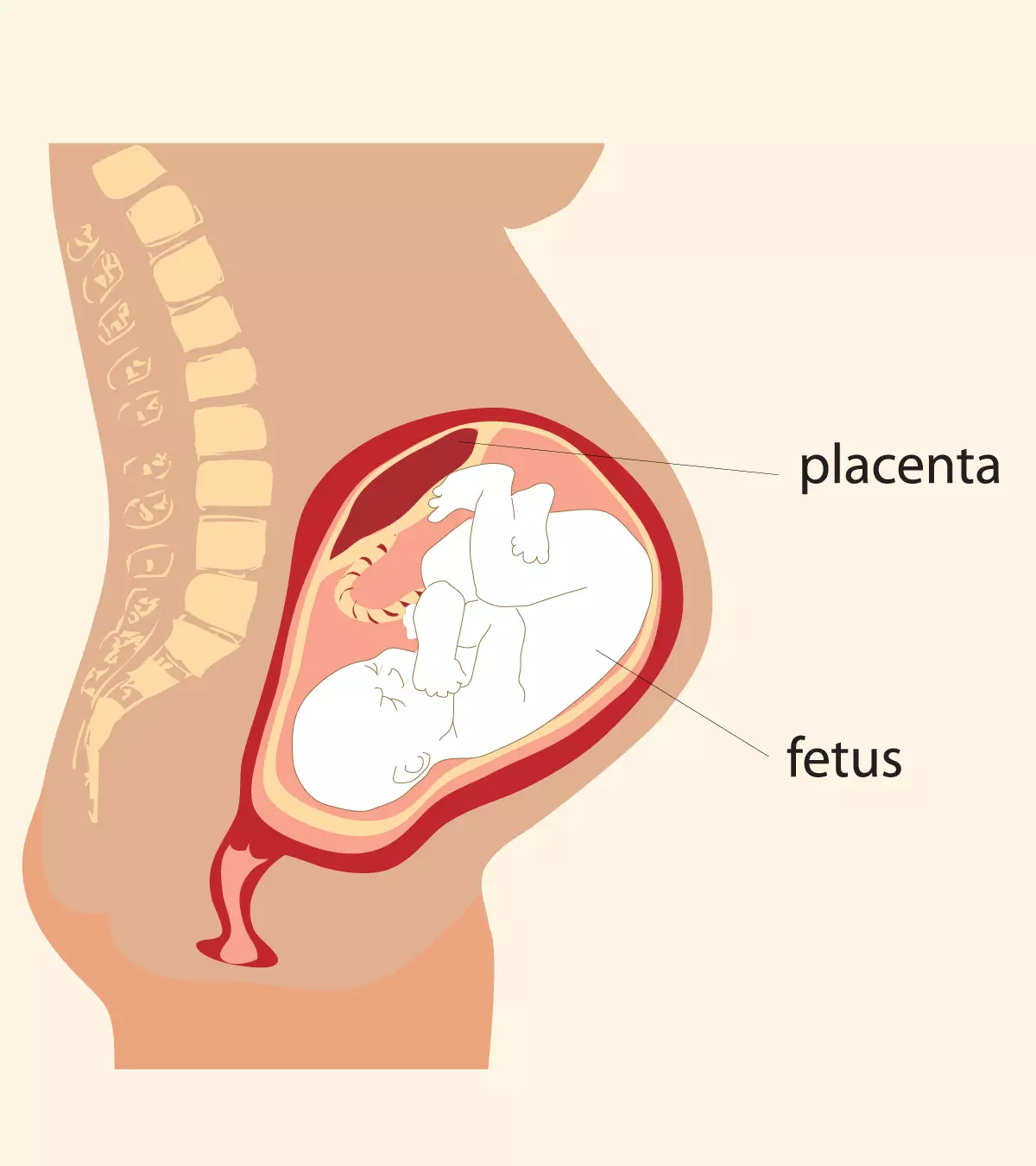
Image: Shutterstock
Tubal ligation, also called female sterilization, is a surgical procedure that irreversibly prevents future pregnancies.
Before the 1960s, surgical sterilization was performed only when warranted by a medical condition or old age or if child-bearing was a health risk (1). However, sterilization procedures for contraceptive reasons came into use in the late 1960s.
It is important to understand the process before considering this permanent method of contraception. Read this post to learn about tubal ligation, how it works, and its advantages and disadvantages.
Key Pointers
- Tubal ligation is a permanent birth control method for women that involves sealing or blocking the fallopian tubes through tying, clipping, cauterizing, or cutting them.
- Laparoscopy and minilaparotomy are the two methods used for this procedure.
- The surgery is performed under anesthesia, and doctors may advise avoiding certain medications beforehand.
- Tubal ligation does not affect hormonal changes, menstrual cycles, or menopause.
- Possible risks of the procedure include pelvic or abdominal pain, ectopic pregnancy, internal bleeding in the abdomen, and reaction to anesthesia.
- In rare cases, ligation procedure failure can result in pregnancy.
What Is Tubal Ligation (Tubectomy)?
Tubal ligation is a popular sterilization method adopted by women all over the world for family planning. In this surgical method, the fallopian tubes are sealed or blocked by tying them together, clipping, cauterizing or cutting. Tubal blockage prevents both the egg and sperm from traveling into the fallopian tube for the union.
This procedure will not affect your menstrual cycle or sex life. Formally, it is known as bilateral tubal ligation (BTL) (2) and is also referred to as ‘tying the tubes’, ‘female sterilization’, ‘tubal sterilization’, or ‘tubal occlusion’.
Tubal ligation is usually done in a hospital or outpatient clinic. You will be either given general anesthesia or local or spinal anesthesia. You cannot become pregnant after the procedure. Though this procedure may be reversed, only 50% – 80% of women will be able to get pregnant after the reversal (3).
Why Might You Need A Tubal Ligation?
You may require this procedure if you do not want to get pregnant due to the following cases or more (3).
- If you are an adult, and sure about not having another pregnancy ever
- If a pregnancy could create health risks to you

This birth control procedure is not a choice if you think you might want another baby in the future.
Also, tubal ligation is ideal when you and your partner agree to the decision of not having children.
When Is Tubal Ligation Performed?
Tubectomy may be performed:
- Following a vaginal delivery. It is performed in the first 24 hours, either on the same day or the following day. A tiny incision is made beneath the belly button (laparoscopy), and a part of fallopian tubes are removed.
- During a C-section. Your recovery will be the same with or without tubal ligation (4).
- Anytime at an outpatient surgical clinic, using a laparoscope and general anesthesia (interval tubal ligation).
Make sure you are thoroughly informed and prepared before going ahead with this procedure.
How Should You Prepare For A Tubal Ligation Procedure?
Before going ahead with the procedure, your doctor will ask why you want tubal ligation and review the following:
- Benefits and risks of the procedure
- Detailed description of the procedure
- Causes and chances of failure
On the days before your surgery:
- Tell the doctor about any medications you are taking. This includes over-the-counter medicines and herbal supplements.
- You may have to stop taking medications such as aspirin, warfarin, and ibuprofen that might result in blood thinning and bleeding.
- You should quit smoking if you have the habit.
On the day of your surgery:
- You will be asked not to eat or drink anything from the night before the surgery.
- Take the regular medicines as instructed by your doctor, with just a small sip of water.
- Wear comfortable clothing to make it easy for you after the surgery (3).
How Is A Tubal Ligation Done?
Surgeons use many different ways of blocking the fallopian tubes. The two primary methods of tubal ligation are laparoscopy and minilaparotomy. An intravenous line is inserted into the vein for injecting medicines and fluids to keep you relaxed. General anesthesia is also given through the IV. In the case of local (spinal in this case) anesthesia, a numbing medicine is given to your spinal region (5).
The main techniques of tubal ligation include (5) (6):
Laparoscopy:

- Your surgeon will make an incision near the belly button or in the lower abdomen.
- Gas is pumped into the abdomen to inflate it. This gives more room for the surgeon to work.
- A laparoscope (a narrow tube with a light and camera) is inserted into the abdomen.
- Another small incision is made in the abdominal wall to insert special instruments which grab and seal the fallopian tubes.
- The tubes may be tied, cut, clamped, sealed or banded using electric current.
- After the procedure, the abdominal incisions are closed through one or two stitches, and the area is covered with a dressing.
- The procedure will take about half an hour.
Minilaparotomy:
- Your surgeon will make one tiny incision in the abdomen.
- The fallopian tubes are located through the cut and can be closed using clips.
- It does not involve the use of a laparoscope or carbon dioxide gas.
Different methods of tubal ligation you should know about:Bipolar coagulation:
This popular method of laparoscopy uses electrical current to cut the sections of the fallopian tube. Tubal damage spreads up to one to two centimeters, and has low long-term failure rates (7).
Fimbriectomy: This procedure removes the portion of the tube close to the ovary(8) Chances of tubal reversal are very limited after fimbriectomy, thus this procedure is not widely performed anymore.
Salpingectomy: It is a complete removal of the fallopian tube and if partly removed it is referred as partial salpingectomy. In this case, reversal is not possible. This is also the preferred method when you want to lower the risk of ovarian cancer (9).
Irving: A proximal segment of the follapian tube is removed and sutured into the uterus posteriorly. The distal portion of the fallopian tube is tied separately. This procedure leaves the sections healthy and is an effective alternative to fimbriectomy or salpingectomy (10).
Unipolar coagulation: This is a less recommended procedure where the doctor uses electrical current to cauterize the tubes. It allows the current to damage the tubes much further from the original clamped site. Pregnancy rates drop to almost 45%, since the tubal damage is more (11).
Tubal clip: Also called Hulka Clip technique, this procedure involves putting up a clip to the fallopian tube. It is fastened so that the passage of eggs is discontinued. Pregnancy rates upon reversal are high, at around 85%.
Falope ring: It involves applying a silastic band or ring to the fallopian tube. Pregnancy rates are high since only a part of the tubal portion is inside the loop.
Pomeroy tubal ligation: A loop of the fallopian tube is strangled by a suture, and then cut and cauterized. It is best for tubal reversal.
Parkland method: Here, the tube is tied at two sites and the segment in between is cut off with an immediate separation of the tubal stumps (12).
Essure: Two small metal coils are inserted into the Fallopian tubes. This causes formation of scar tissue around the coils that block the tubes and prevent sperm from meeting the egg.
Adiana: Two silicone pieces are inserted into the Fallopian tubes. As with the above procedure, a scar tissue forms around the insert, thereby blocking the Fallopian tubes (13).
What Happens After The Tubal Ligation Procedure?
After the surgical procedure, you are kept under observation to check if you have recovered from anesthesia. You are given fluids to drink, and IV is removed. You could go home the same day of the procedure. Going for tubal ligation soon after childbirth will not involve a prolonged hospital stay (2).
- You may be able to resume normal diet and activities gradually.
- Mild discomfort and pain is common, and your doctor may suggest medicines for it.
- Incision areas should be kept dry. Take care when bathing and dressing until the stitches are removed.
- Do not lift anything heavy for at least three weeks, and check with the doctor before resuming such activities.
- You may resume having sex in a week or so after the procedure.
Check with your doctor in the case of:
- Any bleeding, drainage, swelling or redness at the incision site
- Fever or rash
- Increasing pain
- Severe and continuous abdominal pain
- Vomiting or nausea

Lissma, a blogger, shares her experience of undergoing a laparoscopic tubal ligation and what followed. She says, “According to John, I was only in surgery for about 40 minutes before I was taken to recovery, and I was there for an hour and a half, coming out of anesthesia and receiving pain management. From recovery, I was brought back to my room, where my wonderful nurse Linda checked my pain and took my vitals. The most painful part, honestly, and I say this from the couch the following day, was the CO2 gas that they inflated my abdomen with. It actually felt like the worst period cramps ever, including back pain. I slept a lot yesterday, and John was wonderful, setting alarms and getting up with me so I could take my pain meds throughout the night in order to keep them constant in my system.
Now, it’s just recovery time and a follow-up appointment in two weeks. I’m so happy that this was so easy and so happy that, after this pack, I can go off of hormonal birth control forever (i).”
How Long Will It Take To Recover From Tubal Ligation?
Recovery usually takes a day, but again it depends on your physical health. It is always better to take proper rest for at least a couple of days for complete recovery after the procedure.
What Are The Benefits Of Tubal Ligation?
Tubal ligation is effective, permanent, and convenient. According to the US Centers for Disease Control and Prevention (CDC), the typical failure rate of tubal ligation is 0.5%. Some other benefits of this sterilization method are:
- It is a permanent birth control method and prevents the eggs from reaching the ovaries, which means you won’t have to worry about pregnancy at all.
- It causes no hormonal changes, and is thus considered a natural method. It will not affect your menstrual cycle, menopause, or hormones in the body.
- It can make your sex life better as there is no need to use any birth control device or pill.
- It reduces the probability of contracting an infection called the pelvic inflammatory disease (PID).
 Point to consider
Point to considerAre There Any Risks Of Tubal Ligation?
The incidence of risk is one out of 1,000 women. Some possible risks are as follows (3):
- Bleeding at the site of incision or internal bleeding in the abdomen
- Improper wound healing or infections
- Damage to abdominal organs
- Reaction to anesthesia
- Pelvic or abdominal pain
- Ectopic pregnancy, where fertilization happens outside the uterus
- Failure in the procedure, causing an unwanted pregnancy in the future
- Fallopian tube occlusion (14)
These conditions will increase the risk of complications after the surgery.
- Diabetes
- Obesity
- Prior pelvic or abdominal surgery
- Pelvic inflammatory disease
- Lung disease
- Heart disease

Risks could also vary depending on your health condition. Therefore, discuss your health with your doctor before the surgery.
What Are The Alternatives To Tubal Ligation?
Before going ahead with tubal ligation, it is highly essential that you consider the alternatives as well. The other long-acting reversible contraceptives include (15) (16):
- An Intrauterine device (IUD), implanted inside your uterus, prevents pregnancy.
- Birth control implants such as Implanon or Nexplanon, implanted in your arm, release progestin hormone that prevents you from getting pregnant.
- Hysteroscopic sterilization, where a small coil is placed in the Fallopian tubes, causes tissue growth and prevents pregnancy.
- Vasectomy, or getting the man sterilized.
Can You Get Pregnant After Tubal Ligation?
Yes, there is a chance of pregnancy if the Fallopian tubes attach back due to tubal ligation failure. The risk is higher in women who are sterilized at a younger age (17). There is also the possibility that a fertilized egg has been implanted into the uterus before the surgery. This is one of the reasons why tubal ligation is done after giving birth or soon after the menstrual period, when the risk of pregnancy is low.
 Research finds
Research findsWhy Does Tubal Ligation Fail?
Tubal ligation could fail because of (18):
- Luteal phaseiThe second phase of the menstrual cycle, beginning at around day 15, characterized by thickening endometrium. pregnancy, which goes undetected before ligation surgery
- Technical errors during the surgical process
- Inadequate or ineffective closing of Fallopian tubesiMuscular, hollow ducts connecting the uterus with the ovaries to transport eggs during ovulation. during the procedure
- Wrong identification of Fallopian tubes and closing some other part for the tube.
- Natural recanalizationiA non-surgical procedure to clear blockages in the fallopian tubes. post sterilization
- Misplaced device used in the occlusion process
- Failed identification of the tubes due to poor lighting operating
- Presence of pre-existing adhesion (internal scarring after surgeries) that do not give a clear image of the tubes
- Sudden development of tuboperitoneal fistulasiAn abnormal connection between the fallopian tube and peritoneum (abdominal spaces) may lead to ectopic pregnancy. between abdominal spaces because of incomplete healing of the tubes post-surgery
What Are The Symptoms Of Pregnancy After Tubal Ligation?
If your fallopian tube attaches back together, you can continue to have a full-term pregnancy with no issues. Pregnancy after tubal ligation is mainly associated with the following symptoms:
- Missing your periods
- Breast soreness
- Frequent urination
- Unexplained fatigue
- Nausea with certain foods
- Morning sickness
- Food cravings
Take a home pregnancy test or get your doctor to confirm it with a blood test or ultrasound.
Pregnancy Post Tubal Ligation
Once ligation fails, there is every chance that you will get pregnant again.
1. Tubal Pregnancy – Accidental Pregnancy
You are more likely to experience ectopic pregnancy if you conceive post tubal ligation surgery (19).
- Ectopic pregnancy happens when the egg fertilizes anywhere else other than the uterine cavity.
- Ectopic pregnancy is risky and life threatening. The fetus will start growing in the Fallopian tube, which may eventually expand, rupture and cause severe bleeding and shock.
- Ectopic pregnancy will not see a full term.
- You will need to consult your doctor immediately if you conceive after ligation
2. Pregnancy by choice:
In case you wish to have a baby after you have undergone a successful tubal ligation, you can either go for tubal reversal surgery or opt for in-vitro fertilizationiA procedure in which a woman’s egg and a man’s sperm are mixed in a laboratory to form an embryo to be inserted into the uterus. .
a. Tubal Reversal Surgery:
This procedure may be done by laparoscopy or laparotomy and is also called Tubal Reanastomosis (20).
- The ligated portion of the tube is cut and the fresh ends of the tube are attached back to each other.
- Post procedure factors like the sperm quality of the male, the status of any possible pelvic conditions, the tubal status, your age, and the quality and quantity of egg determines the chances of a pregnancy.
After a successful tubal reversal, normal intercourse without any medications or supplements is enough to get pregnant.
b. In-Vitro Fertilization:
This procedure helps you avoid any major surgery (21).
- The eggs and sperm are collected and are transferred into a test tube for fertilization.
- After fertilization, some of the embryos are transferred back to the uterus so that one of them will be implanted.
- Within 14 days, you will know if the procedure is successful.
- You may have the risk of having multiple pregnancies.
Post Tubal Ligation Syndrome
Post Tubal Ligation Syndrome (PTLS) is a syndrome of certain symptoms reported by women who have undergone tubal ligation. About 37% of women experience this syndrome and it most likely affects those who got the tubes tied at a younger age (22).
Symptoms of PTLS
The most predominant symptoms include:
- Irregular or heavier periods
- Hot flashes

PTLS is associated with other medical conditions such as:
- Hormonal imbalance
- Castrative menopause
- Ovarian isolation
- Hormonal shock
- Atrophic ovariesiA condition identified as a reduced ovarian tissue volume indicating ovarian failure and interrupted ovarian blood supply.
- Osteoporosis or bone loss
- Dysfunctional uterine bleeding
- Severe pelvic adhesions
- Misplacement of female organs
- EndometriosisiThe condition identified by an abnormal growth of intrauterine tissues outside the uterus leading to irregular and painful periods.
- Decreased ability of lactation
Is there a treatment for PTLS?
Treatment for PTLS is only tubal ligation reversal. There have been cases of women whose health improved after the reversal procedure.
Frequently Asked Questions
1. Do you still have a period after tubal ligation?
Yes. After going through the tubal ligation procedure, you will have your periods as usual. This permanent birth control measure does not affect the menstrual cycle (5).
2. What is the age limit for a tubal reversal?
In general, a tubal reversal procedure is the best option for women younger than 40 years who have undergone tubal ligation after childbirth. Women over 40 may also undergo tubal reversal procedures, but their chances of getting pregnant are lower than those younger than 40.
3. Is tubal ligation covered by insurance?
Tubal ligation might be a totally free-of-cost or at least low-cost procedure when you are covered by insurance. Under The Affordable Care Act, most insurance plans cover birth control, including certain female sterilization methods. Medicaid and other government programs can also aid individuals seeking tubal ligation (24).
4. How much does tubal ligation cost without insurance?
The cost of tubal ligation without insurance can vary depending on the healthcare provider, location, and additional services required. However, it generally amounts to around $6,000 in the United States (24).
5. Will I still need to use contraception after having tubal ligation?
Tubal ligation ensures permanent pregnancy prevention, eliminating the need for birth control. However, it does not safeguard against sexually transmitted infections (STIs) (25).
6. How does tubal ligation compare to other forms of birth control regarding effectiveness and safety?
Tubal ligation is an incredibly effective birth control method, with a success rate of over 99% in preventing pregnancy. It provides lifelong, uninterrupted protection without the need for extra contraception. However, to minimize the risk of STDs, using condoms is recommended. If you desire a reversible yet highly effective option, consider alternatives such as the IUD or the implant. These methods also yield a success rate of over 99% and can be removed by a healthcare professional when you decide to conceive (25).
Tubectomy or tubal ligation is a female sterilization procedure involving surgical removal, closure, or clipping of the fallopian tubes. Each month, the ovum released from the ovary reaches the uterus to the fallopian tube for fertilization, so blocking this connection could permanently prevent pregnancy. This can be done through laparoscopy or minilaparotomy using various surgical techniques. Women who do not want to continue having children or couples who do not want to have a child with hereditary genetic abnormalities are encouraged to opt for tubectomy. For many women, it brings relief from the worry of unexpected pregnancies, helping them feel more in control of their reproductive choices. However, it is recommended to make a tubectomy decision after detailed analysis since the ligation reversal is difficult and less successful.
Infographic: Popular Misconceptions And Facts About Tubal Ligation Procedure
Tubal ligation or tubectomy is a permanent procedure for birth control. The reversal surgery is riskier and less successful. Go through the infographic to know common misconceptions and facts about the female sterilization procedure to make more informed decisions. Illustration: Momjunction Design Team
Illustration: Tubal Ligation: What It Is Procedure Benefits And Risks

Image: Dall·E/MomJunction Design Team
Learn about the alternate ways of getting pregnant after undergoing a tubal ligation procedure, the chances of its success, possible risks associated with it, and other important aspects from a licensed medical practitioner.
Personal Experience: Source
MomJunction articles include first-hand experiences to provide you with better insights through real-life narratives. Here are the sources of personal accounts referenced in this article.
i. The tubal ligation experience of my dreams;https://ageneralmalaise.blogspot.com/2015/05/the-tubal-ligation-experience-of-my.html
References
1. Seiler JS; The evolution of tubal sterilization; Obstet Gynecol Surv (1984)
2. Tubal ligation; U.S. National Library of Medicine (2018)
3. Tubal Ligation; University of Rochester Medical Center (2018)
4. Postpartum Tubal Ligation; University of Michigan Health System
5. Tubal Ligation; John Hopkins Medicine
6. Sterilization for Women and Men; American College of Obstetricians and Gynecologists
7. Sudha Salhan;Textbook of Gynecology; Page 539
8. Jonathan S. Berek; Berek & Novak’s Gynecology; page 1219
9. Tubal Ligation; John Hopkins Medicine
10. Bnai Zion Medical Center; Salpingectomy During Cesarean Section (SCS); U.S. National Library of Medicine
11. Milad M1, Le L; Laparoscopic Irving tubal sterilization. A case report; J Reprod Med (1998)
12. Types of Tubal Ligation; NCCRM
13. Female Sterilization; From Contraceptive Sterilization: Global Issues and Trends, EngenderHealth (2002)
14. Sophia N Palmer & James A Greenberg; Transcervical Sterilization: A Comparison of Essure® Permanent Birth Control System and Adiana® Permanent Contraception System; Rev Obstet Gynecol (2009)
15. Dharam Persaud et al; An Introduction and High Yield Summary of Female Contraceptive Methods; Florida International University FIU Digital Commons (2017)
16. Contraception; Centers for Disease Control and Prevention
17. Herbert B. Peterson et al; The risk of pregnancy after tubal sterilization: Findings from the U.S. Collaborative Review of Sterilization; American Journal Of Obstetrics And Gynecology (1996)
18. Meriah Fahey; Spontaneous Expulsion of Tubal Ligation Clips: A Case Report; Journal of Obstetrics and Gynaecology Canada
19. Ectopic Pregnancy; University of Rochester Medical Center (2018)
20. Tubal Ligation Reversal; Baylor College of Medicine
21. K Jayakrishnan & Sumeet N Baheti; Laparoscopic tubal sterilization reversal and fertility outcomes; J Hum Reprod Sci. (2011)
22. Post Tubal Ligation Syndrome; NCCRM
23. Female Sterilization; Science Direct
24. How do I get a tubal ligation procedure?; Planned Parenthood Federation of America
25. What is the Effectiveness of a Tubal Ligation Procedure?; Planned Parenthood Federation of America
Community Experiences
Join the conversation and become a part of our nurturing community! Share your stories, experiences, and insights to connect with fellow parents.
Read full bio of Dr. Surakshith Battina
Read full bio of Rebecca Malachi
Read full bio of Swati Patwal
Read full bio of Aneesha Amonz

















